SIM335 Managing Projects: Acquisition Project Report
VerifiedAdded on 2021/06/22
|9
|2688
|96
Report
AI Summary
This assignment solution for SIM335 Managing Projects comprises two tasks. Task 1 includes short answer questions covering project characteristics, project life cycle stages, the purpose of a Project Initiation Document (PID), knowledge areas in project management, feasibility studies, and a network diagram with critical path calculation. Task 2 presents a case study where the student, assuming the role of Roxanne, a senior employee at ABC PLC, must write a detailed report outlining the activities required to successfully manage the acquisition of DEF Ltd. The report should address project management processes, project life cycle stages, required skills and competencies of the project manager, potential problems, and solutions, ensuring the project is completed on time and within budget. The report must adhere to specific word count requirements and assessment criteria, including report presentation, use of relevant theory, and analysis. The assignment emphasizes the application of project management principles to a real-world business scenario, demonstrating the student's understanding of project planning, execution, and control within the context of a corporate acquisition.
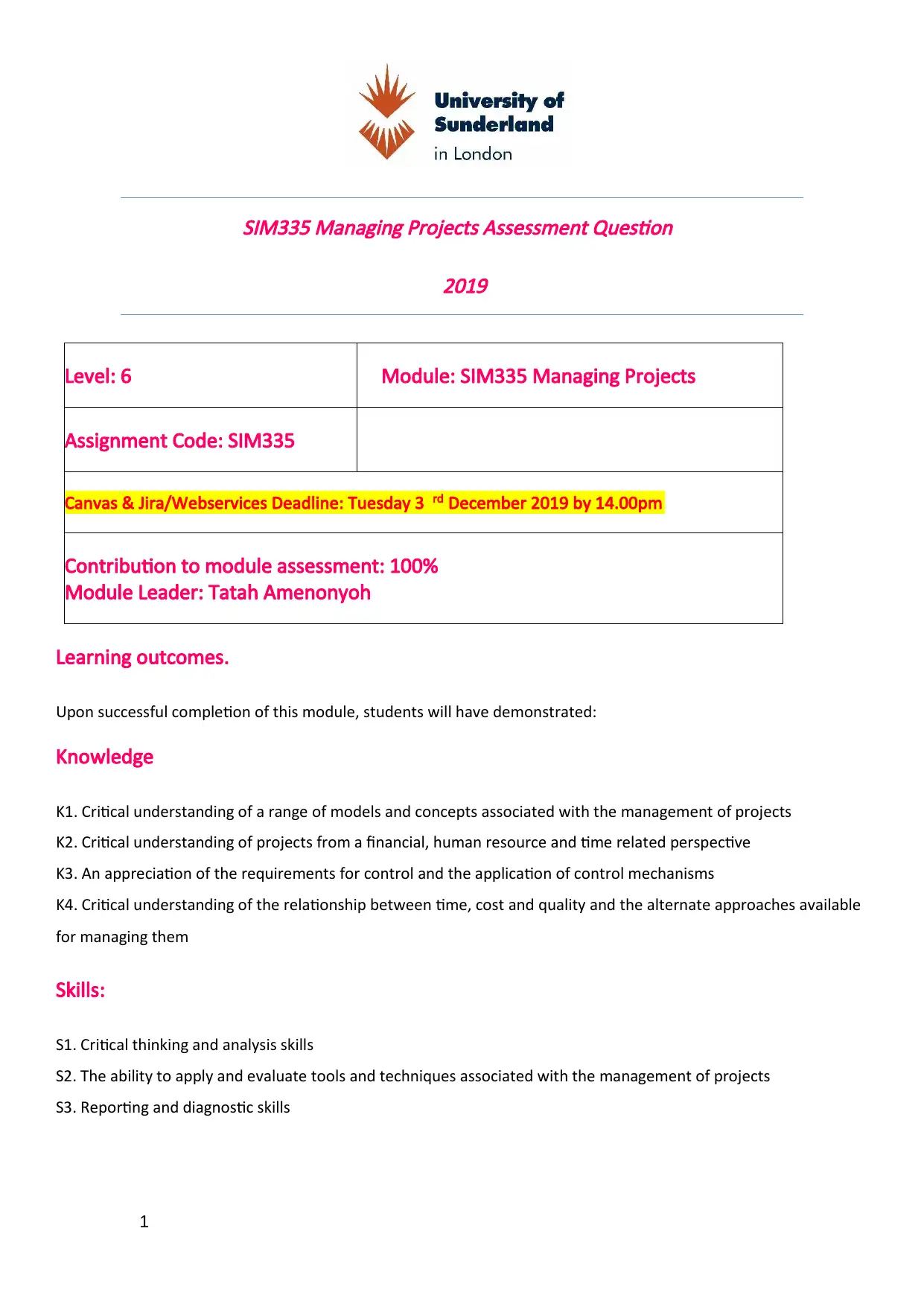
1
SIM335 Managing Projects Assessment Question
2019
Level: 6 Module: SIM335 Managing Projects
Assignment Code: SIM335
Canvas & Jira/Webservices Deadline: Tuesday 3 rd December 2019 by 14.00pm
Contribution to module assessment: 100%
Module Leader: Tatah Amenonyoh
Learning outcomes.
Upon successful completion of this module, students will have demonstrated:
Knowledge
K1. Critical understanding of a range of models and concepts associated with the management of projects
K2. Critical understanding of projects from a financial, human resource and time related perspective
K3. An appreciation of the requirements for control and the application of control mechanisms
K4. Critical understanding of the relationship between time, cost and quality and the alternate approaches available
for managing them
Skills:
S1. Critical thinking and analysis skills
S2. The ability to apply and evaluate tools and techniques associated with the management of projects
S3. Reporting and diagnostic skills
SIM335 Managing Projects Assessment Question
2019
Level: 6 Module: SIM335 Managing Projects
Assignment Code: SIM335
Canvas & Jira/Webservices Deadline: Tuesday 3 rd December 2019 by 14.00pm
Contribution to module assessment: 100%
Module Leader: Tatah Amenonyoh
Learning outcomes.
Upon successful completion of this module, students will have demonstrated:
Knowledge
K1. Critical understanding of a range of models and concepts associated with the management of projects
K2. Critical understanding of projects from a financial, human resource and time related perspective
K3. An appreciation of the requirements for control and the application of control mechanisms
K4. Critical understanding of the relationship between time, cost and quality and the alternate approaches available
for managing them
Skills:
S1. Critical thinking and analysis skills
S2. The ability to apply and evaluate tools and techniques associated with the management of projects
S3. Reporting and diagnostic skills
Paraphrase This Document
Need a fresh take? Get an instant paraphrase of this document with our AI Paraphraser
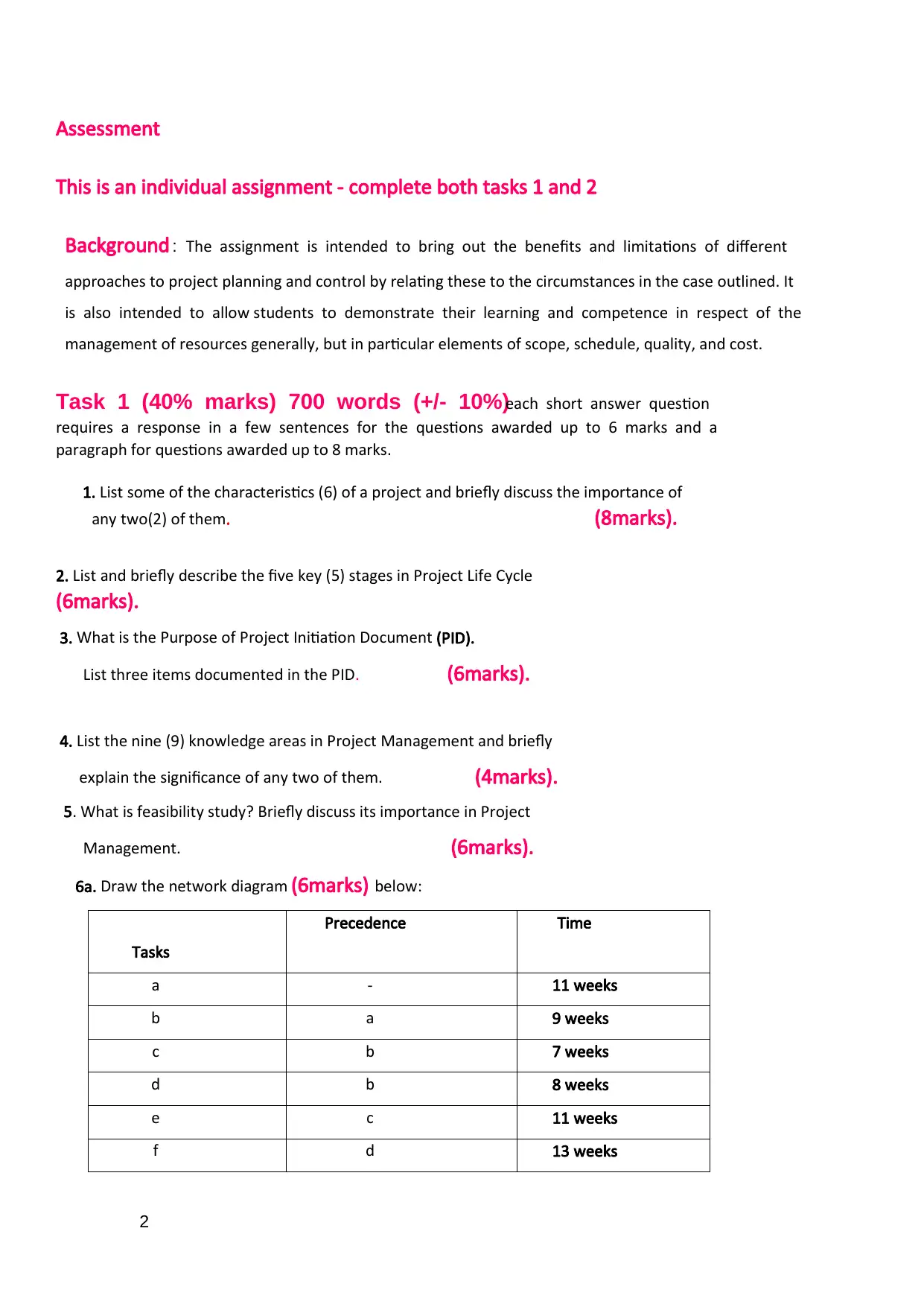
2
Assessment
This is an individual assignment - complete both tasks 1 and 2
Background : The assignment is intended to bring out the benefits and limitations of different
approaches to project planning and control by relating these to the circumstances in the case outlined. It
is also intended to allow students to demonstrate their learning and competence in respect of the
management of resources generally, but in particular elements of scope, schedule, quality, and cost.
Task 1 (40% marks) 700 words (+/- 10%)each short answer question
requires a response in a few sentences for the questions awarded up to 6 marks and a
paragraph for questions awarded up to 8 marks.
1. List some of the characteristics (6) of a project and briefly discuss the importance of
any two(2) of them. (8marks).
2. List and briefly describe the five key (5) stages in Project Life Cycle
(6marks).
3. What is the Purpose of Project Initiation Document (PID).
List three items documented in the PID. (6marks).
4. List the nine (9) knowledge areas in Project Management and briefly
explain the significance of any two of them. (4marks).
5. What is feasibility study? Briefly discuss its importance in Project
Management. (6marks).
6a. Draw the network diagram (6marks) below:
Tasks
Precedence Time
a - 11 weeks
b a 9 weeks
c b 7 weeks
d b 8 weeks
e c 11 weeks
f d 13 weeks
Assessment
This is an individual assignment - complete both tasks 1 and 2
Background : The assignment is intended to bring out the benefits and limitations of different
approaches to project planning and control by relating these to the circumstances in the case outlined. It
is also intended to allow students to demonstrate their learning and competence in respect of the
management of resources generally, but in particular elements of scope, schedule, quality, and cost.
Task 1 (40% marks) 700 words (+/- 10%)each short answer question
requires a response in a few sentences for the questions awarded up to 6 marks and a
paragraph for questions awarded up to 8 marks.
1. List some of the characteristics (6) of a project and briefly discuss the importance of
any two(2) of them. (8marks).
2. List and briefly describe the five key (5) stages in Project Life Cycle
(6marks).
3. What is the Purpose of Project Initiation Document (PID).
List three items documented in the PID. (6marks).
4. List the nine (9) knowledge areas in Project Management and briefly
explain the significance of any two of them. (4marks).
5. What is feasibility study? Briefly discuss its importance in Project
Management. (6marks).
6a. Draw the network diagram (6marks) below:
Tasks
Precedence Time
a - 11 weeks
b a 9 weeks
c b 7 weeks
d b 8 weeks
e c 11 weeks
f d 13 weeks
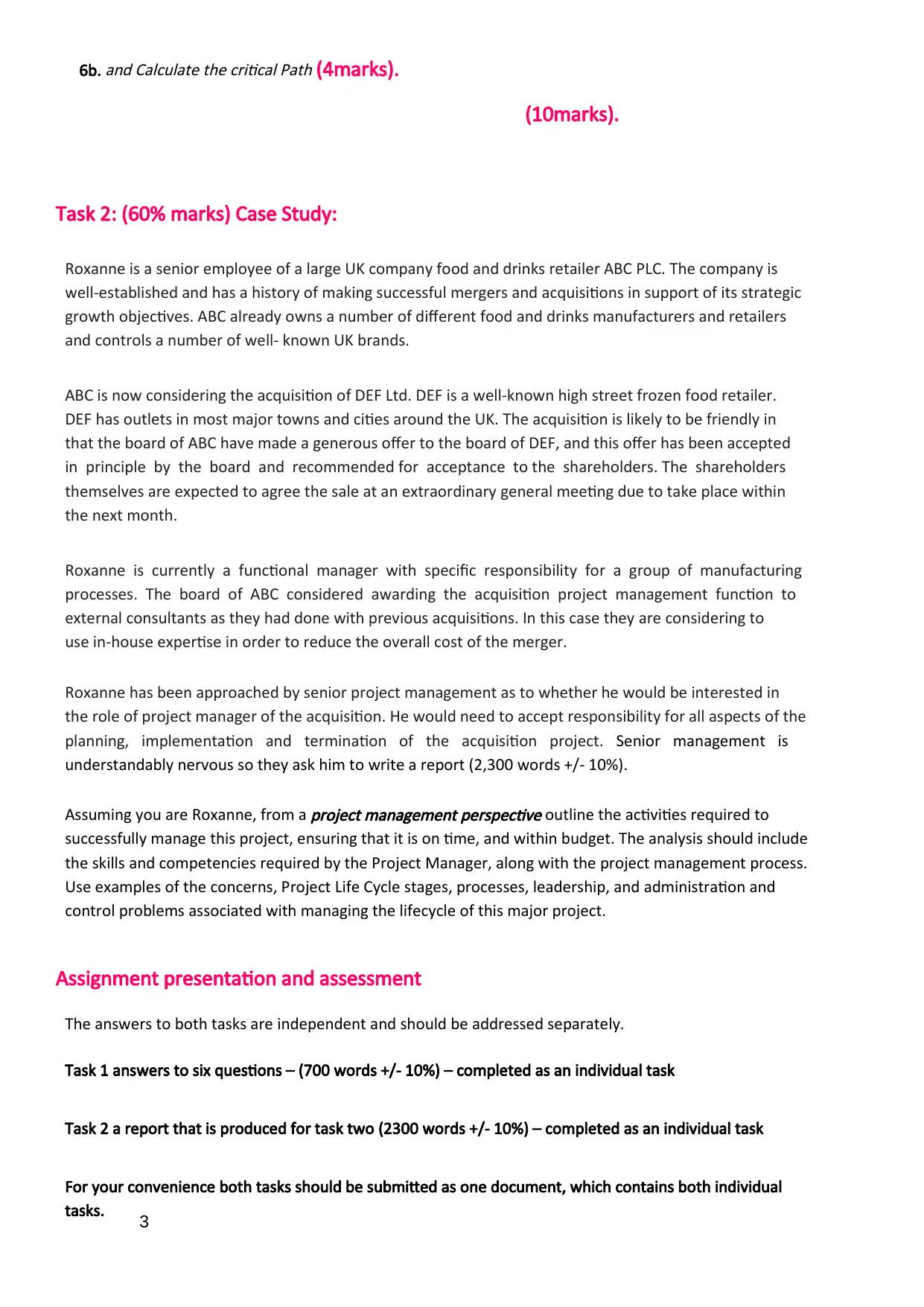
3
6b.
and Calculate the critical Path (4marks).
(10marks).
Task 2: (60% marks) Case Study:
Roxanne is a senior employee of a large UK company food and drinks retailer ABC PLC. The company is
well-established and has a history of making successful mergers and acquisitions in support of its strategic
growth objectives. ABC already owns a number of different food and drinks manufacturers and retailers
and controls a number of well- known UK brands.
ABC is now considering the acquisition of DEF Ltd. DEF is a well-known high street frozen food retailer.
DEF has outlets in most major towns and cities around the UK. The acquisition is likely to be friendly in
that the board of ABC have made a generous offer to the board of DEF, and this offer has been accepted
in principle by the board and recommended for acceptance to the shareholders. The shareholders
themselves are expected to agree the sale at an extraordinary general meeting due to take place within
the next month.
Roxanne is currently a functional manager with specific responsibility for a group of manufacturing
processes. The board of ABC considered awarding the acquisition project management function to
external consultants as they had done with previous acquisitions. In this case they are considering to
use in-house expertise in order to reduce the overall cost of the merger.
Roxanne has been approached by senior project management as to whether he would be interested in
the role of project manager of the acquisition. He would need to accept responsibility for all aspects of the
planning, implementation and termination of the acquisition project. Senior management is
understandably nervous so they ask him to write a report (2,300 words +/- 10%).
Assuming you are Roxanne, from a
project management perspective outline the activities required to
successfully manage this project, ensuring that it is on time, and within budget. The analysis should include
the skills and competencies required by the Project Manager, along with the project management process.
Use examples of the concerns, Project Life Cycle stages, processes, leadership, and administration and
control problems associated with managing the lifecycle of this major project.
Assignment presentation and assessment
The answers to both tasks are independent and should be addressed separately.
Task 1 answers to six questions – (700 words +/- 10%) – completed as an individual task
Task 2 a report that is produced for task two (2300 words +/- 10%) – completed as an individual task
For your convenience both tasks should be submitted as one document, which contains both individual
tasks.
6b.
and Calculate the critical Path (4marks).
(10marks).
Task 2: (60% marks) Case Study:
Roxanne is a senior employee of a large UK company food and drinks retailer ABC PLC. The company is
well-established and has a history of making successful mergers and acquisitions in support of its strategic
growth objectives. ABC already owns a number of different food and drinks manufacturers and retailers
and controls a number of well- known UK brands.
ABC is now considering the acquisition of DEF Ltd. DEF is a well-known high street frozen food retailer.
DEF has outlets in most major towns and cities around the UK. The acquisition is likely to be friendly in
that the board of ABC have made a generous offer to the board of DEF, and this offer has been accepted
in principle by the board and recommended for acceptance to the shareholders. The shareholders
themselves are expected to agree the sale at an extraordinary general meeting due to take place within
the next month.
Roxanne is currently a functional manager with specific responsibility for a group of manufacturing
processes. The board of ABC considered awarding the acquisition project management function to
external consultants as they had done with previous acquisitions. In this case they are considering to
use in-house expertise in order to reduce the overall cost of the merger.
Roxanne has been approached by senior project management as to whether he would be interested in
the role of project manager of the acquisition. He would need to accept responsibility for all aspects of the
planning, implementation and termination of the acquisition project. Senior management is
understandably nervous so they ask him to write a report (2,300 words +/- 10%).
Assuming you are Roxanne, from a
project management perspective outline the activities required to
successfully manage this project, ensuring that it is on time, and within budget. The analysis should include
the skills and competencies required by the Project Manager, along with the project management process.
Use examples of the concerns, Project Life Cycle stages, processes, leadership, and administration and
control problems associated with managing the lifecycle of this major project.
Assignment presentation and assessment
The answers to both tasks are independent and should be addressed separately.
Task 1 answers to six questions – (700 words +/- 10%) – completed as an individual task
Task 2 a report that is produced for task two (2300 words +/- 10%) – completed as an individual task
For your convenience both tasks should be submitted as one document, which contains both individual
tasks.
⊘ This is a preview!⊘
Do you want full access?
Subscribe today to unlock all pages.

Trusted by 1+ million students worldwide
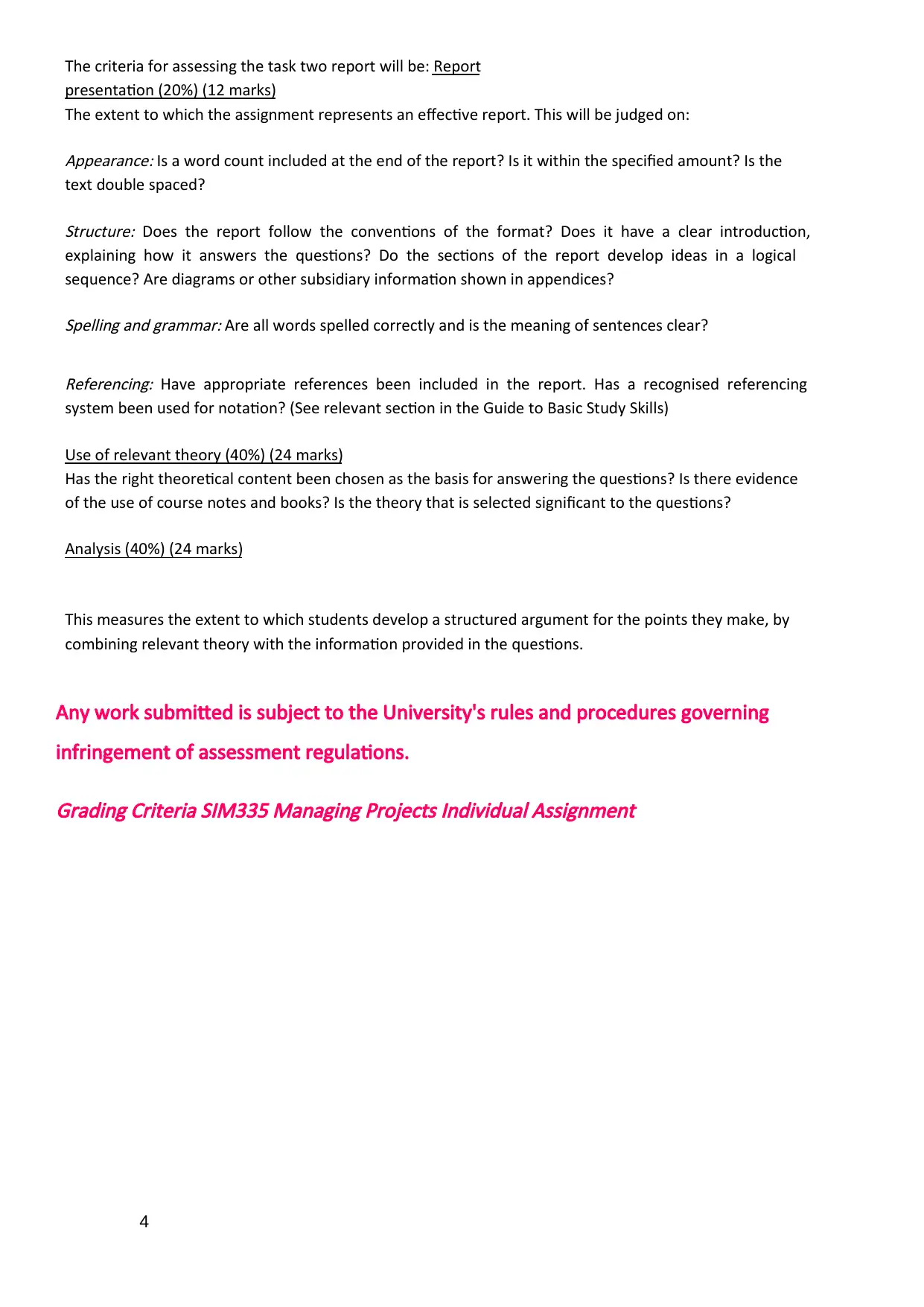
4
The criteria for assessing the task two report will be: Report
presentation (20%) (12 marks)
The extent to which the assignment represents an effective report. This will be judged on:
Appearance: Is a word count included at the end of the report? Is it within the specified amount? Is the
text double spaced?
Structure: Does the report follow the conventions of the format? Does it have a clear introduction,
explaining how it answers the questions? Do the sections of the report develop ideas in a logical
sequence? Are diagrams or other subsidiary information shown in appendices?
Spelling and grammar: Are all words spelled correctly and is the meaning of sentences clear?
Referencing: Have appropriate references been included in the report. Has a recognised referencing
system been used for notation? (See relevant section in the Guide to Basic Study Skills)
Use of relevant theory (40%) (24 marks)
Has the right theoretical content been chosen as the basis for answering the questions? Is there evidence
of the use of course notes and books? Is the theory that is selected significant to the questions?
Analysis (40%) (24 marks)
This measures the extent to which students develop a structured argument for the points they make, by
combining relevant theory with the information provided in the questions.
Any work submitted is subject to the University's rules and procedures governing
infringement of assessment regulations.
Grading Criteria SIM335 Managing Projects Individual Assignment
The criteria for assessing the task two report will be: Report
presentation (20%) (12 marks)
The extent to which the assignment represents an effective report. This will be judged on:
Appearance: Is a word count included at the end of the report? Is it within the specified amount? Is the
text double spaced?
Structure: Does the report follow the conventions of the format? Does it have a clear introduction,
explaining how it answers the questions? Do the sections of the report develop ideas in a logical
sequence? Are diagrams or other subsidiary information shown in appendices?
Spelling and grammar: Are all words spelled correctly and is the meaning of sentences clear?
Referencing: Have appropriate references been included in the report. Has a recognised referencing
system been used for notation? (See relevant section in the Guide to Basic Study Skills)
Use of relevant theory (40%) (24 marks)
Has the right theoretical content been chosen as the basis for answering the questions? Is there evidence
of the use of course notes and books? Is the theory that is selected significant to the questions?
Analysis (40%) (24 marks)
This measures the extent to which students develop a structured argument for the points they make, by
combining relevant theory with the information provided in the questions.
Any work submitted is subject to the University's rules and procedures governing
infringement of assessment regulations.
Grading Criteria SIM335 Managing Projects Individual Assignment
Paraphrase This Document
Need a fresh take? Get an instant paraphrase of this document with our AI Paraphraser
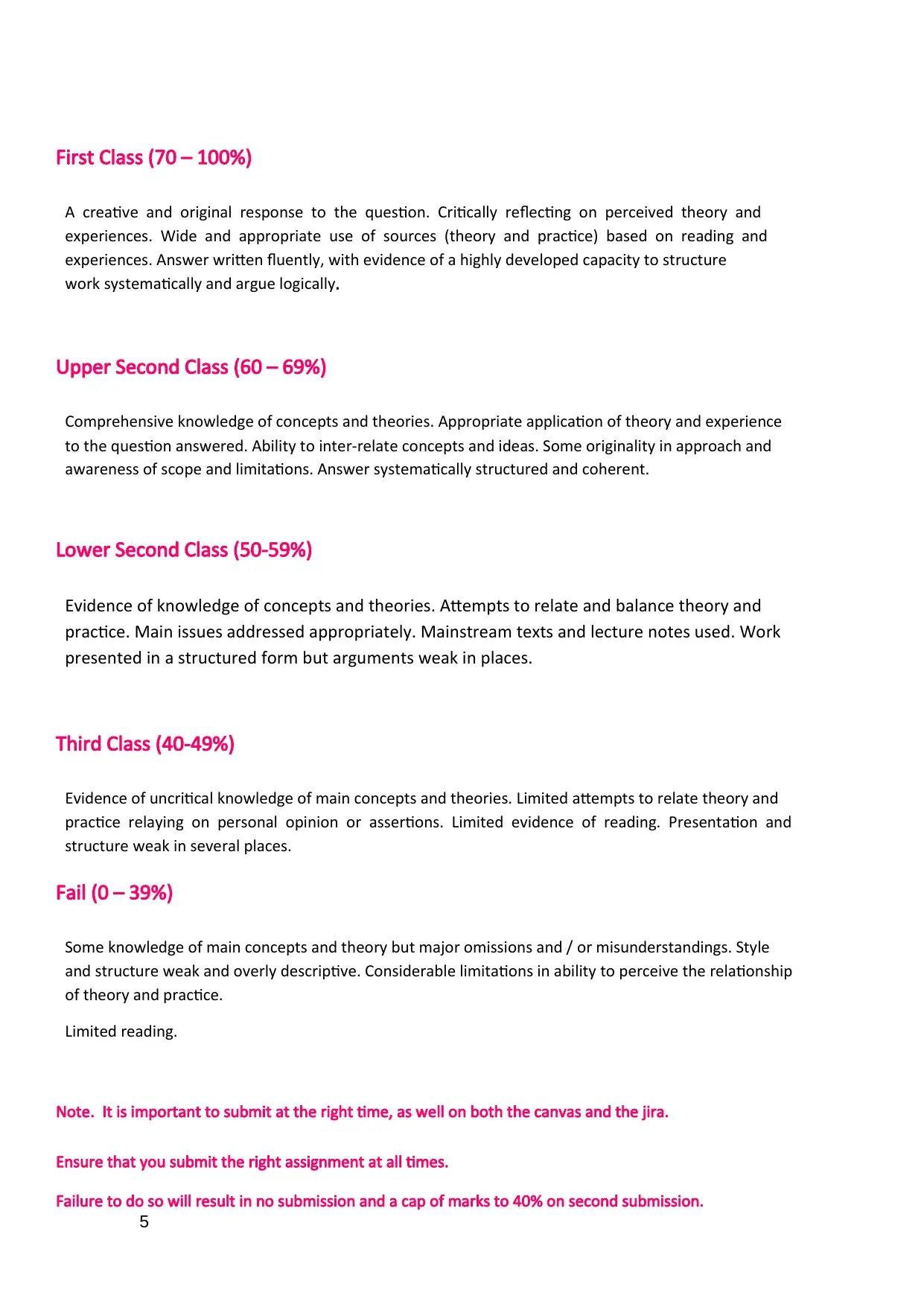
5
First Class (70 – 100%)
A creative and original response to the question. Critically reflecting on perceived theory and
experiences. Wide and appropriate use of sources (theory and practice) based on reading and
experiences. Answer written fluently, with evidence of a highly developed capacity to structure
work systematically and argue logically.
Upper Second Class (60 – 69%)
Comprehensive knowledge of concepts and theories. Appropriate application of theory and experience
to the question answered. Ability to inter-relate concepts and ideas. Some originality in approach and
awareness of scope and limitations. Answer systematically structured and coherent.
Lower Second Class (50-59%)
Evidence of knowledge of concepts and theories. Attempts to relate and balance theory and
practice. Main issues addressed appropriately. Mainstream texts and lecture notes used. Work
presented in a structured form but arguments weak in places.
Third Class (40-49%)
Evidence of uncritical knowledge of main concepts and theories. Limited attempts to relate theory and
practice relaying on personal opinion or assertions. Limited evidence of reading. Presentation and
structure weak in several places.
Fail (0 – 39%)
Some knowledge of main concepts and theory but major omissions and / or misunderstandings. Style
and structure weak and overly descriptive. Considerable limitations in ability to perceive the relationship
of theory and practice.
Limited reading.
Note. It is important to submit at the right time, as well on both the canvas and the jira.
Ensure that you submit the right assignment at all times.
Failure to do so will result in no submission and a cap of marks to 40% on second submission.
First Class (70 – 100%)
A creative and original response to the question. Critically reflecting on perceived theory and
experiences. Wide and appropriate use of sources (theory and practice) based on reading and
experiences. Answer written fluently, with evidence of a highly developed capacity to structure
work systematically and argue logically.
Upper Second Class (60 – 69%)
Comprehensive knowledge of concepts and theories. Appropriate application of theory and experience
to the question answered. Ability to inter-relate concepts and ideas. Some originality in approach and
awareness of scope and limitations. Answer systematically structured and coherent.
Lower Second Class (50-59%)
Evidence of knowledge of concepts and theories. Attempts to relate and balance theory and
practice. Main issues addressed appropriately. Mainstream texts and lecture notes used. Work
presented in a structured form but arguments weak in places.
Third Class (40-49%)
Evidence of uncritical knowledge of main concepts and theories. Limited attempts to relate theory and
practice relaying on personal opinion or assertions. Limited evidence of reading. Presentation and
structure weak in several places.
Fail (0 – 39%)
Some knowledge of main concepts and theory but major omissions and / or misunderstandings. Style
and structure weak and overly descriptive. Considerable limitations in ability to perceive the relationship
of theory and practice.
Limited reading.
Note. It is important to submit at the right time, as well on both the canvas and the jira.
Ensure that you submit the right assignment at all times.
Failure to do so will result in no submission and a cap of marks to 40% on second submission.
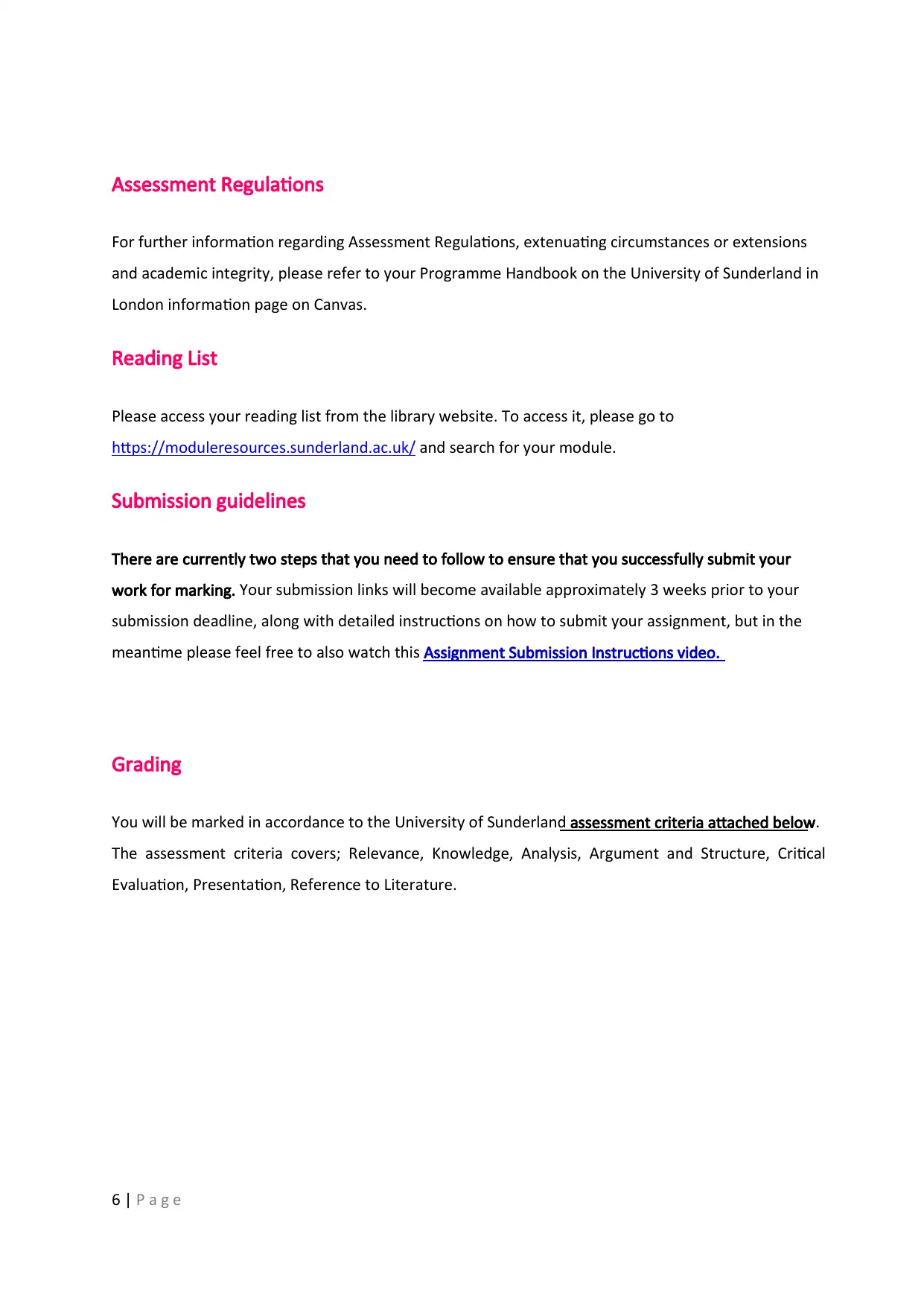
6 | P a g e
Assessment Regulations
For further information regarding Assessment Regulations, extenuating circumstances or extensions
and academic integrity, please refer to your Programme Handbook on the University of Sunderland in
London information page on Canvas.
Reading List
Please access your reading list from the library website. To access it, please go to
https://moduleresources.sunderland.ac.uk/ and search for your module.
Submission guidelines
There are currently two steps that you need to follow to ensure that you successfully submit your
work for marking. Your submission links will become available approximately 3 weeks prior to your
submission deadline, along with detailed instructions on how to submit your assignment, but in the
meantime please feel free to also watch this Assignment Submission Instructions video.
Grading
You will be marked in accordance to the University of Sunderland assessment criteria attached below.
The assessment criteria covers; Relevance, Knowledge, Analysis, Argument and Structure, Critical
Evaluation, Presentation, Reference to Literature.
Assessment Regulations
For further information regarding Assessment Regulations, extenuating circumstances or extensions
and academic integrity, please refer to your Programme Handbook on the University of Sunderland in
London information page on Canvas.
Reading List
Please access your reading list from the library website. To access it, please go to
https://moduleresources.sunderland.ac.uk/ and search for your module.
Submission guidelines
There are currently two steps that you need to follow to ensure that you successfully submit your
work for marking. Your submission links will become available approximately 3 weeks prior to your
submission deadline, along with detailed instructions on how to submit your assignment, but in the
meantime please feel free to also watch this Assignment Submission Instructions video.
Grading
You will be marked in accordance to the University of Sunderland assessment criteria attached below.
The assessment criteria covers; Relevance, Knowledge, Analysis, Argument and Structure, Critical
Evaluation, Presentation, Reference to Literature.
⊘ This is a preview!⊘
Do you want full access?
Subscribe today to unlock all pages.

Trusted by 1+ million students worldwide
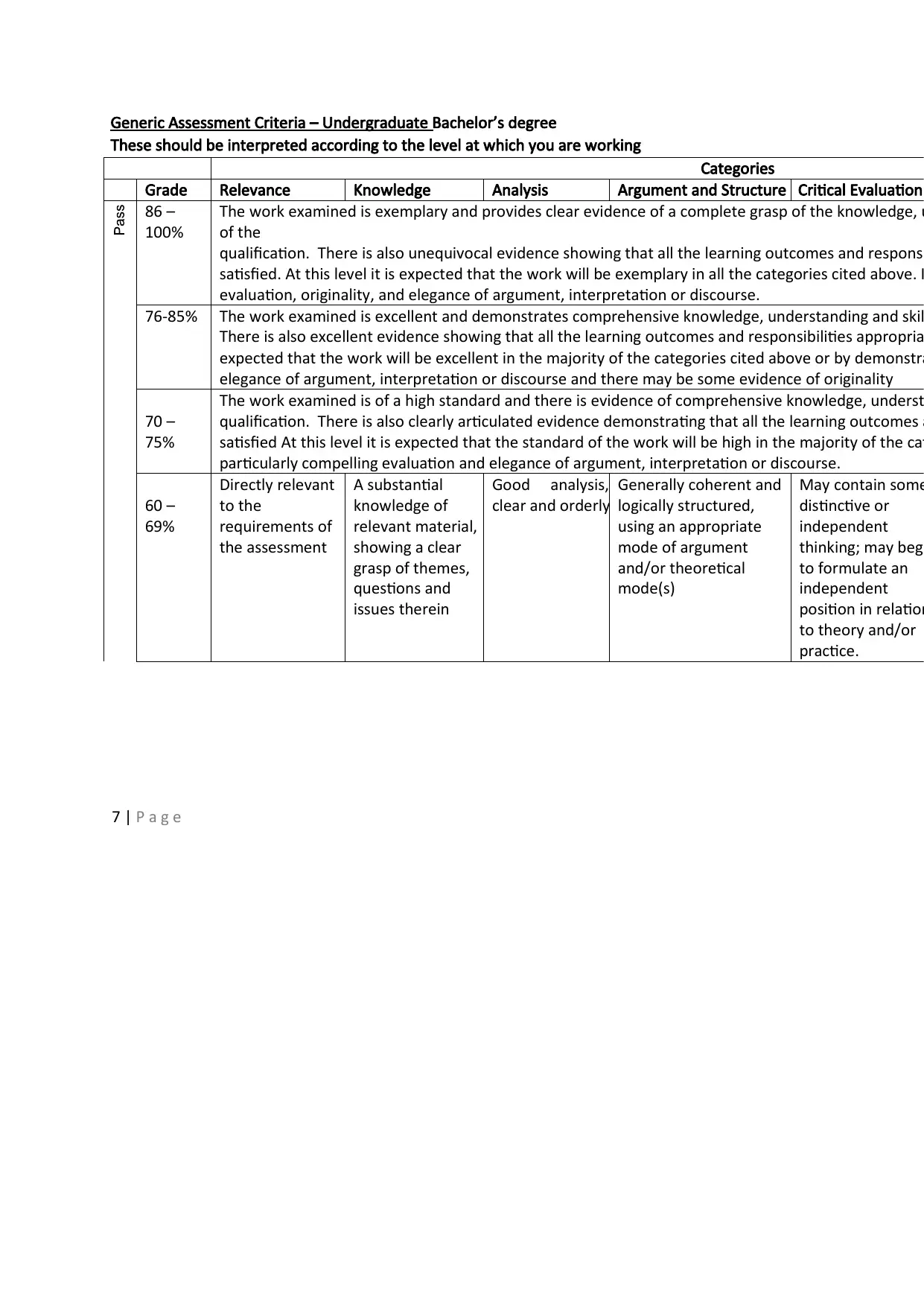
7 | P a g e
Generic Assessment Criteria – Undergraduate Bachelor’s degree
These should be interpreted according to the level at which you are working
Categories
Grade Relevance Knowledge Analysis Argument and Structure Critical Evaluation
86 –
100%
The work examined is exemplary and provides clear evidence of a complete grasp of the knowledge, u
of the
qualification. There is also unequivocal evidence showing that all the learning outcomes and responsi
satisfied. At this level it is expected that the work will be exemplary in all the categories cited above. I
evaluation, originality, and elegance of argument, interpretation or discourse.
76-85% The work examined is excellent and demonstrates comprehensive knowledge, understanding and skil
There is also excellent evidence showing that all the learning outcomes and responsibilities appropria
expected that the work will be excellent in the majority of the categories cited above or by demonstra
elegance of argument, interpretation or discourse and there may be some evidence of originality
70 –
75%
The work examined is of a high standard and there is evidence of comprehensive knowledge, underst
qualification. There is also clearly articulated evidence demonstrating that all the learning outcomes a
satisfied At this level it is expected that the standard of the work will be high in the majority of the cat
particularly compelling evaluation and elegance of argument, interpretation or discourse.
60 –
69%
Directly relevant
to the
requirements of
the assessment
A substantial
knowledge of
relevant material,
showing a clear
grasp of themes,
questions and
issues therein
Good analysis,
clear and orderly
Generally coherent and
logically structured,
using an appropriate
mode of argument
and/or theoretical
mode(s)
May contain some
distinctive or
independent
thinking; may begi
to formulate an
independent
position in relation
to theory and/or
practice.
Generic Assessment Criteria – Undergraduate Bachelor’s degree
These should be interpreted according to the level at which you are working
Categories
Grade Relevance Knowledge Analysis Argument and Structure Critical Evaluation
86 –
100%
The work examined is exemplary and provides clear evidence of a complete grasp of the knowledge, u
of the
qualification. There is also unequivocal evidence showing that all the learning outcomes and responsi
satisfied. At this level it is expected that the work will be exemplary in all the categories cited above. I
evaluation, originality, and elegance of argument, interpretation or discourse.
76-85% The work examined is excellent and demonstrates comprehensive knowledge, understanding and skil
There is also excellent evidence showing that all the learning outcomes and responsibilities appropria
expected that the work will be excellent in the majority of the categories cited above or by demonstra
elegance of argument, interpretation or discourse and there may be some evidence of originality
70 –
75%
The work examined is of a high standard and there is evidence of comprehensive knowledge, underst
qualification. There is also clearly articulated evidence demonstrating that all the learning outcomes a
satisfied At this level it is expected that the standard of the work will be high in the majority of the cat
particularly compelling evaluation and elegance of argument, interpretation or discourse.
60 –
69%
Directly relevant
to the
requirements of
the assessment
A substantial
knowledge of
relevant material,
showing a clear
grasp of themes,
questions and
issues therein
Good analysis,
clear and orderly
Generally coherent and
logically structured,
using an appropriate
mode of argument
and/or theoretical
mode(s)
May contain some
distinctive or
independent
thinking; may begi
to formulate an
independent
position in relation
to theory and/or
practice.
Paraphrase This Document
Need a fresh take? Get an instant paraphrase of this document with our AI Paraphraser
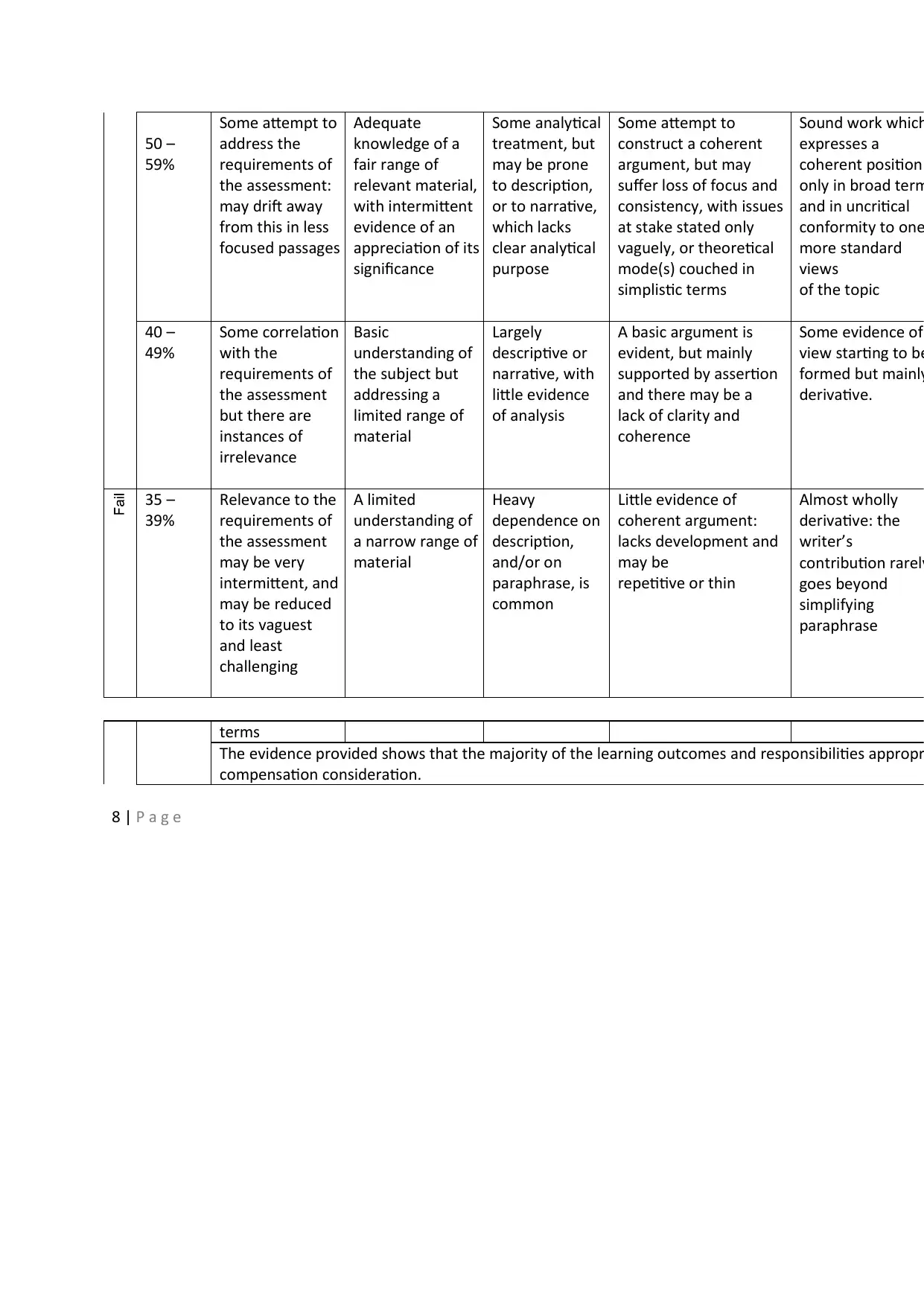
8 | P a g e
50 –
59%
Some attempt to
address the
requirements of
the assessment:
may drift away
from this in less
focused passages
Adequate
knowledge of a
fair range of
relevant material,
with intermittent
evidence of an
appreciation of its
significance
Some analytical
treatment, but
may be prone
to description,
or to narrative,
which lacks
clear analytical
purpose
Some attempt to
construct a coherent
argument, but may
suffer loss of focus and
consistency, with issues
at stake stated only
vaguely, or theoretical
mode(s) couched in
simplistic terms
Sound work which
expresses a
coherent position
only in broad term
and in uncritical
conformity to one
more standard
views
of the topic
40 –
49%
Some correlation
with the
requirements of
the assessment
but there are
instances of
irrelevance
Basic
understanding of
the subject but
addressing a
limited range of
material
Largely
descriptive or
narrative, with
little evidence
of analysis
A basic argument is
evident, but mainly
supported by assertion
and there may be a
lack of clarity and
coherence
Some evidence of
view starting to be
formed but mainly
derivative.
35 –
39%
Relevance to the
requirements of
the assessment
may be very
intermittent, and
may be reduced
to its vaguest
and least
challenging
A limited
understanding of
a narrow range of
material
Heavy
dependence on
description,
and/or on
paraphrase, is
common
Little evidence of
coherent argument:
lacks development and
may be
repetitive or thin
Almost wholly
derivative: the
writer’s
contribution rarely
goes beyond
simplifying
paraphrase
terms
The evidence provided shows that the majority of the learning outcomes and responsibilities appropr
compensation consideration.
50 –
59%
Some attempt to
address the
requirements of
the assessment:
may drift away
from this in less
focused passages
Adequate
knowledge of a
fair range of
relevant material,
with intermittent
evidence of an
appreciation of its
significance
Some analytical
treatment, but
may be prone
to description,
or to narrative,
which lacks
clear analytical
purpose
Some attempt to
construct a coherent
argument, but may
suffer loss of focus and
consistency, with issues
at stake stated only
vaguely, or theoretical
mode(s) couched in
simplistic terms
Sound work which
expresses a
coherent position
only in broad term
and in uncritical
conformity to one
more standard
views
of the topic
40 –
49%
Some correlation
with the
requirements of
the assessment
but there are
instances of
irrelevance
Basic
understanding of
the subject but
addressing a
limited range of
material
Largely
descriptive or
narrative, with
little evidence
of analysis
A basic argument is
evident, but mainly
supported by assertion
and there may be a
lack of clarity and
coherence
Some evidence of
view starting to be
formed but mainly
derivative.
35 –
39%
Relevance to the
requirements of
the assessment
may be very
intermittent, and
may be reduced
to its vaguest
and least
challenging
A limited
understanding of
a narrow range of
material
Heavy
dependence on
description,
and/or on
paraphrase, is
common
Little evidence of
coherent argument:
lacks development and
may be
repetitive or thin
Almost wholly
derivative: the
writer’s
contribution rarely
goes beyond
simplifying
paraphrase
terms
The evidence provided shows that the majority of the learning outcomes and responsibilities appropr
compensation consideration.
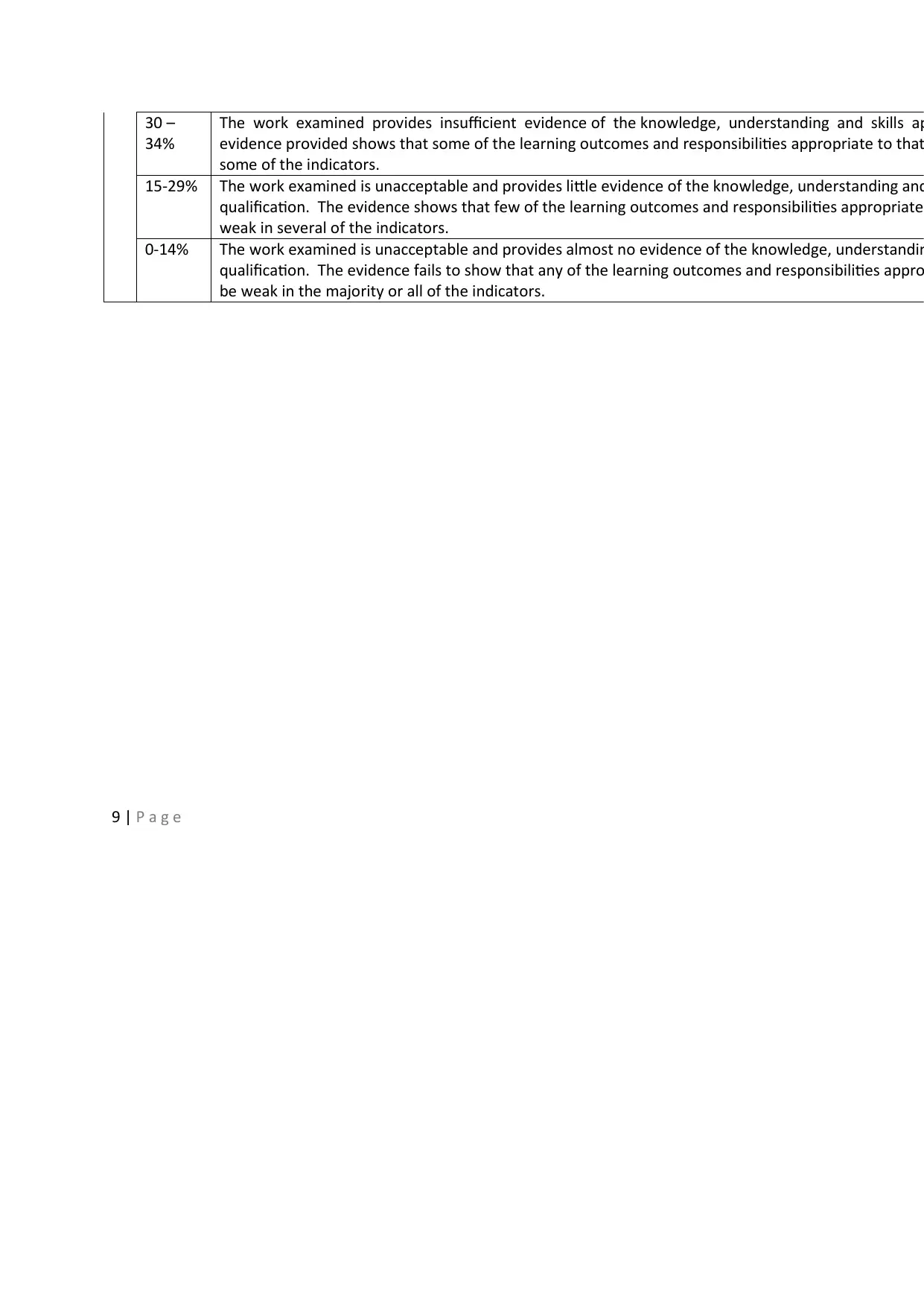
9 | P a g e
30 –
34%
The work examined provides insufficient evidence of the knowledge, understanding and skills ap
evidence provided shows that some of the learning outcomes and responsibilities appropriate to that
some of the indicators.
15-29% The work examined is unacceptable and provides little evidence of the knowledge, understanding and
qualification. The evidence shows that few of the learning outcomes and responsibilities appropriate
weak in several of the indicators.
0-14% The work examined is unacceptable and provides almost no evidence of the knowledge, understandin
qualification. The evidence fails to show that any of the learning outcomes and responsibilities appro
be weak in the majority or all of the indicators.
30 –
34%
The work examined provides insufficient evidence of the knowledge, understanding and skills ap
evidence provided shows that some of the learning outcomes and responsibilities appropriate to that
some of the indicators.
15-29% The work examined is unacceptable and provides little evidence of the knowledge, understanding and
qualification. The evidence shows that few of the learning outcomes and responsibilities appropriate
weak in several of the indicators.
0-14% The work examined is unacceptable and provides almost no evidence of the knowledge, understandin
qualification. The evidence fails to show that any of the learning outcomes and responsibilities appro
be weak in the majority or all of the indicators.
⊘ This is a preview!⊘
Do you want full access?
Subscribe today to unlock all pages.

Trusted by 1+ million students worldwide
1 out of 9
Related Documents
Your All-in-One AI-Powered Toolkit for Academic Success.
+13062052269
info@desklib.com
Available 24*7 on WhatsApp / Email
![[object Object]](/_next/static/media/star-bottom.7253800d.svg)
Unlock your academic potential
Copyright © 2020–2025 A2Z Services. All Rights Reserved. Developed and managed by ZUCOL.




